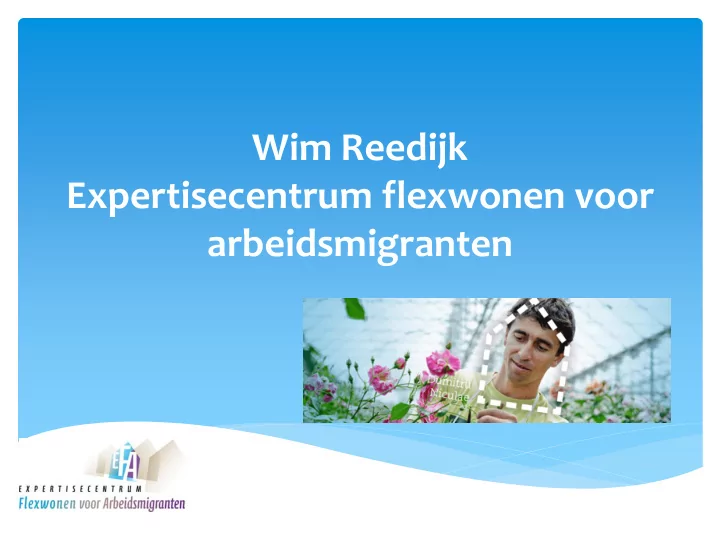

Wim Reedijk Expertisecentrum flexwonen voor arbeidsmigranten
The presentation 1. Programm Flexwonen voor Arbeidsmigranten 2. Results until now 3. Strategy: enforcement or housing? 4. Some examples
Parliamentary inquiry (2011) Conclusions: 1. Tackling malicious employment agencies 2. More and better housing for labor migrants And: Sense of urgency! Joint responsibility: municipalities, employers and housing providers Appeal to the government: take the lead in the process
National Statement on Housing Labour migrants (2012) 17 National organizations signed, including the government, VNG (national organisation of municipalities, Aedes (housing associations), employers organizations and trade unions Together we developed the program "Flex Housing for labor migrants' Primary focus on nine regions; over there should municipalities, employers and housing providers reach agreements
Starting points program "Flex Housing for labor migrants ' Regions are and remain responsible for creating more and better housing The parties of the National Statement supporting the process The Minister of Housing and parliament follow the process closely The Centre of Expertise 'Flex Housing for labor migrants' helps in word and deed
Task for local authorities, employers and housing providers: 1. Adequate housing which meets at least the nationally established standards 2. Adequate enforcement, for a level playing field 3. Registration of migrant workers in BRP, our national register of citizens 4. Good information and communication, to migrant workers and to the local community
Where do we stand in 2016? 1. EU labor migrants The exact numbers are still unknown; shifts in numbers and provenance More than 400.000 labor migrants from Central, Eastern and Southern Europe: they do live 'somewhere' Some live properly, but much don’t About 20 to 30% will settle here long lasting
Where do we stand in 2016? 2. The parties involved Municipalities: in all 9 regions we have administrative agreements; the issue is on the agenda. Housing providers: growing role for private housing providers, limited role for housing associations (mostly long stay, mid or short stay very limited) Employers have set quality standards for housing: certification mark SNF
Where do we stand in 2016? 3. The agreements Administrative Consultation with the minister of housing observed: we’re on the right track, but we're not there yet! There are agreements for 31.000 additional housing sites in the nine regions. About 50% of these are realised or in production. Ongoing commitment and support of all parties is very important!
Strategy: enforcement or housing? Labour migration is primarily based on pull-effects; our employers invite the people to come here . Economic importance is great, now in many sectors of the economy Therefore, as long as there is insufficient legal housing, enforcement leads to an endless and costly cat-and-mouse game Bonafide employers have a need of good agreements
Enforcement ánd housing! A policy of just providing housing does not work well When there is a lack of enforcement there will be no level playing field for housing providers and employers; pressure on prices leads to exploitation and slum landlords The SNF certification mark placed a bottom in the market. Our goal is to connect it up with enforcement
Facilitating housing Housing itself is not a task of the (local) government, but facilitating housing providers ís! That can be done by: supportive planning policy identifying / providing locations helping with transforming real estate process support, for example to inform local residents effective enforcement
Housing facilities Partly scattered throughout the city in ordinary housing. Partly in larger complexes ranging from 20 up to 600 residents. Greater numbers in ordinary homes can cause problems: overcrowding, parking problems
Difference between short and long term Large scale facilities are easier to manage and more comfortable for the (short stay) labor migrants themselves; Here it is possible to realize sports and leisure facilities. When they are good the residents in the house will have sufficient entertainment. Short-term labor migrants appreciate ready-made solutions, including facilities for entertainment, sports, etc. For the long stay, private accommodation and integration become important
Some examples: Stella Maris in Steenbergen: 400 residents Flexhotel Zuiderpark in Rotterdam: 250 residents
Stella Maris
Stella Maris
Flexhotel Zuiderpark
Finally… Your questions and comments See also www.flexwonenarbeidsmigranten.nl (sorry, only in dutch) •
Recommend
More recommend